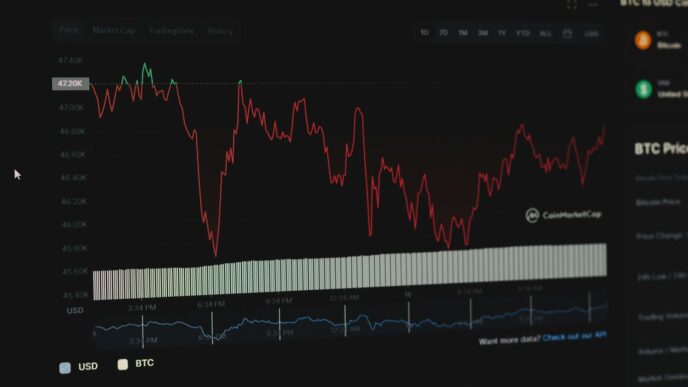So, you’re thinking about adding some smaller companies to your investment mix? That’s a smart move if you’re looking for growth. These small cap companies, while sometimes a bit bumpy, can really make a difference in your portfolio. But, like anything, you can’t just jump in blindly. We need to figure out what makes them tick and how to pick the good ones. It’s not rocket science, but it does take a bit of looking around.
Key Takeaways
- Small cap companies are businesses with a smaller market value, often seen as having more room to grow but also carrying more risk.
- Finding good small cap companies means looking at their money situation, if they’re doing something new and different, and who’s running the show.
- Don’t put all your money in one small cap stock; spread it around to lower your risk.
- Investing in small cap companies is usually best if you plan to hold onto them for a long time.
- Always do your homework and understand the risks before investing in any small cap company.
Understanding The Small Cap Landscape
Defining Small Cap Companies
So, what exactly are we talking about when we say "small cap"? Basically, these are companies that aren’t giants in the stock market. Think of them as the up-and-comers. Their total value, what investors call market capitalization, is usually somewhere between $300 million and $2 billion. It’s a pretty wide range, but the main idea is they’re smaller than the big, household names you see everywhere. Because they’re smaller, they often have more room to grow. It’s like a small sapling versus a giant redwood – the sapling has a lot more potential to get bigger, right?
The Allure of High Growth Potential
This is where things get interesting for investors. Small companies, because they’re smaller, can sometimes grow much faster than established giants. Imagine a small bakery that suddenly gets a huge order and has to ramp up production – that’s the kind of rapid expansion we’re talking about. They might be introducing a new product, expanding into a new area, or just catching a trend at the right time. This potential for rapid growth is the main reason people look at small caps, hoping for bigger returns than you might get from a more stable, larger company. It’s not guaranteed, of course, but the possibility is there. It’s like finding a diamond in the rough before everyone else does.
Navigating Inherent Volatility
Now, let’s talk about the flip side. Because these companies are smaller and often less established, their stock prices can bounce around a lot more than those of big companies. One day a stock might jump up 10%, and the next it could drop 10%. This is called volatility. It means there’s more risk involved. Think about it: a big company might have a bad quarter and its stock dips a bit. A small company might have a bad quarter, and its stock could really take a hit. It’s important to be aware of this. Investing in small caps means you need to be comfortable with these ups and downs. It’s not for someone who wants a perfectly smooth ride. You need to be prepared for some bumps along the way. Here are a few things to keep in mind:
- Market Sensitivity: Small caps can react more strongly to news, both good and bad.
- Liquidity Issues: Sometimes, it’s harder to buy or sell small cap stocks quickly without affecting the price, because fewer people are trading them.
- Company-Specific Risks: A single bad decision or a problem with a key product can have a bigger impact on a small company than on a large one.
Identifying Promising Small Cap Companies
So, you’re looking to find those hidden gems in the small-cap world, huh? It’s not as simple as just picking a name out of a hat, but it’s definitely doable if you know what to look for. These smaller companies can be a goldmine for growth, but they also come with their own set of challenges. The trick is to find companies that have solid foundations and are doing something genuinely new or better.
When I’m looking at small caps, I usually start by digging into their numbers. It’s like checking the engine of a car before you buy it. You want to see if it’s running smoothly.
Analyzing Strong Fundamentals
This means looking at things like how much money they’re bringing in (revenue) and if that number is going up consistently. Are they actually making a profit, or are they just spending money? And how much debt do they have? A company that’s drowning in debt isn’t usually a good bet, even if it’s growing fast. I like to see a healthy balance sheet, meaning they have more assets than liabilities and aren’t borrowing too much.
Here’s a quick checklist I often use:
- Revenue Growth: Is the top line increasing year over year? Look for steady, not just one-off, increases.
- Profitability: Are they making money? Check net income and profit margins. Are margins improving or shrinking?
- Debt Levels: How much do they owe? A low debt-to-equity ratio is generally a good sign.
- Cash Flow: Do they have enough cash coming in to cover their expenses and investments? Positive operating cash flow is key.
Spotting Disruptive Technologies
Beyond the numbers, sometimes the most exciting small caps are the ones changing the game. Think about companies that are creating new technologies or finding a completely different way to do things. These are the companies that could really take off. It’s a bit riskier, sure, because these new ideas don’t always pan out, but the rewards can be huge if they do. You’re looking for companies that are ahead of the curve, maybe in areas like AI, renewable energy, or biotech. It’s about identifying trends before they become mainstream.
Evaluating Management Teams and Valuation Metrics
Who’s actually running the show? A smart, experienced management team can make all the difference. Do they have a clear vision? Have they successfully led companies before? Their track record matters. You can often find this information in their investor relations section or in news articles about the company. Also, don’t forget about the price you’re paying. Even a great company can be a bad investment if you overpay. You’ll want to look at things like the Price-to-Earnings (P/E) ratio, Price-to-Sales (P/S) ratio, and compare them to similar companies in the same industry. If a company’s stock price seems way too high compared to its earnings or sales, it might be a warning sign.
Strategic Approaches to Small Cap Investing

Alright, so you’re thinking about dipping your toes into the small-cap stock pool. That’s cool, but it’s not exactly like picking up pennies off the sidewalk. These smaller companies can be a goldmine, sure, but they also come with their own set of challenges. To really make this work for you, you need a plan. It’s not just about finding a hot stock and hoping for the best.
The Importance of Diversification
First off, don’t put all your money into one or two small-cap companies. That’s a recipe for disaster. If that one company hits a rough patch, your whole investment could take a serious hit. Spreading your money around is key. Think of it like having a bunch of different plants in your garden; if one gets a bug, the others are usually fine. For small caps, this means owning shares in several different companies, ideally across different industries. This way, if one stock tanks, the others might be doing great, balancing things out.
Here’s a simple way to think about it:
- Don’t Over-Concentrate: Avoid having more than 5-10% of your small-cap allocation in any single stock.
- Industry Spread: Try to invest in companies from various sectors – tech, healthcare, consumer goods, whatever looks promising.
- Geographic Mix: If possible, look at companies in different regions, not just your home country.
Adopting a Long-Term Investment Horizon
Small-cap stocks can be pretty jumpy. Their prices can swing up and down quite a bit, sometimes for reasons that aren’t immediately clear. Trying to time the market with these stocks is a losing game for most people. Instead, think of yourself as planting a tree, not buying a lottery ticket. You want to invest in companies you believe have solid growth potential over several years, maybe even a decade or more. This long-term view helps you ride out those short-term price drops without panicking and selling at the wrong time. Patience is really the name of the game here.
Implementing Robust Risk Management
Because small caps can be volatile, you absolutely need a plan for managing the risks. This isn’t about being scared; it’s about being smart. You need to know how much you’re willing to lose on any single investment before you even make it. Setting limits is important. Sometimes, people use what are called stop-loss orders. Basically, if a stock drops to a certain price, your shares are automatically sold to prevent bigger losses. It’s like having a safety net. You also need to regularly check in on your investments. Are the companies still doing what you thought they would? Has anything changed in their industry? Staying informed helps you make better decisions and adjust your strategy if needed. Being prepared for potential losses is a sign of a mature investor.
Global Opportunities in Small Cap Stocks
While many investors stick to the familiar territory of large, established companies, there’s a whole world of smaller businesses out there, spread across different countries, that could be real winners. It’s easy to get caught up in what’s happening in your own backyard, but looking beyond your borders can open up some pretty interesting possibilities for your portfolio.
Exploring Undiscovered Gems in Asia
Asia, with its rapidly growing economies and burgeoning middle class, is a hotbed for small-cap innovation. Think about companies that are catering to millions of new consumers entering the market, or those developing technologies that solve local problems but have global potential. These aren’t always the companies you hear about on the nightly news, but that’s part of the appeal. Because they’re less followed by big investment funds, individual investors can sometimes find them at more attractive prices.
- Focus on sectors like e-commerce and fintech: These areas are booming as more people get online and use digital services for the first time.
- Look for companies addressing local needs: Solutions for infrastructure, healthcare, or sustainable energy in developing Asian markets can have massive growth.
- Consider the regulatory environment: Understand the local rules and how they might affect a business’s operations and growth.
Canadian Small Caps Poised for Growth
Canada might be known for its natural resources, but its small-cap scene is much more diverse than you might think. There are plenty of tech startups, innovative healthcare companies, and specialized industrial firms that are quietly building strong businesses. These companies often benefit from a stable political climate and a well-regulated financial system, which can reduce some of the risk associated with smaller, less-known businesses.
- Biotechnology and life sciences: Canada has a strong research base, leading to exciting developments in this sector.
- Clean technology: With a global push for sustainability, Canadian companies in this space are well-positioned.
- Specialty manufacturing: Niche manufacturers creating high-quality components or finished goods can find strong demand.
United States Small Cap Value Plays
Even in the massive U.S. market, there are small companies that might be flying under the radar, trading at prices that don’t quite reflect their true worth. These aren’t necessarily the flashy tech darlings; they might be older, established businesses in traditional industries that have fallen out of favor but still have solid earnings and assets. Finding these ‘value’ plays means digging a bit deeper, looking at balance sheets, and understanding why the market might be undervaluing them. It’s about finding quality at a discount.
| Company Name | Industry | P/E Ratio | Price/Book | Notes |
|---|---|---|---|---|
| Example Mfg. Inc. | Industrial Goods | 12.5x | 1.1x | Steady revenue, strong cash flow |
| Regional Bank Corp. | Financial Services | 9.8x | 0.9x | Undervalued assets, good dividend |
| Niche Software LLC | Software & Services | 15.0x | 2.5x | Growing customer base, recurring rev |
Remember, investing globally means dealing with different currencies, political landscapes, and economic conditions. It’s not as simple as picking stocks at home, but the potential rewards can make the extra effort worthwhile. Always do your homework, and don’t be afraid to look beyond the obvious places.
Realistic Expectations for Small Cap Returns
So, you’re looking at small-cap stocks and seeing that potential for big gains, maybe even that 60% upside some reports are talking about. That’s exciting, for sure. But let’s pump the brakes a little and talk about what that really means. It’s not like picking up a winning lottery ticket; it’s more like planting a garden. You put in the work, you hope for the best, but you also know some things might not grow as planned.
Understanding Market Cycles and Projections
First off, those upside projections? They’re educated guesses, based on what things look like right now. Markets are always moving, like the tide. Sometimes they’re high, sometimes they’re low, and small companies feel those shifts even more. A company that looks like a sure bet today might face unexpected headwinds tomorrow. It’s why keeping an eye on the bigger economic picture is pretty important.
- Economic Slowdowns: When the economy hits a rough patch, smaller companies often struggle more than the big guys. They might not have the cash reserves to ride it out.
- Interest Rate Changes: Rising interest rates can make borrowing money more expensive for small businesses, slowing down their growth plans.
- Industry Trends: A hot new trend can lift a small company, but what happens when that trend fades? It’s a risk.
The Role of Due Diligence
This is where you really earn your keep as an investor. You can’t just pick a name out of a hat. You’ve got to dig in. That means looking at the company’s money – are they making sales? Are they spending more than they earn? Who’s actually running the show, and do they seem like they know what they’re doing? It’s a lot like checking out a used car before you buy it. You wouldn’t just hand over cash without looking under the hood, right?
Here’s a quick checklist:
- Financial Health: Check their revenue growth, profit margins, and how much debt they have. Are these numbers going up or down?
- Management Quality: Look into the leadership team. Do they have a solid track record? What’s their vision?
- Competitive Edge: What makes this company special? Do they have a unique product or service that others can’t easily copy?
- Valuation: Is the stock price reasonable compared to what the company is worth? Sometimes a great company can be a bad investment if you pay too much.
When to Seek Professional Guidance
Look, nobody knows everything about investing. Especially with small caps, which can be a bit wild. If you’re feeling overwhelmed, or if you’ve got a lot riding on this, talking to someone who does this for a living makes a lot of sense. They can help you figure out if small caps fit into your overall plan and how much risk you should be taking. It’s better to ask for directions than to get lost in the woods. They can also help you understand that 60% upside isn’t a promise, but a possibility, and help you build a strategy that accounts for both the good and the bad.
Wrapping It Up
So, we’ve talked about how small companies can sometimes be overlooked, but they can also be where the real growth happens. It’s not always easy, and yeah, there’s more risk involved than with the big guys. But by looking at the numbers, seeing who’s got a solid plan, and keeping an eye on how the market’s doing, you can find some pretty interesting opportunities. Just remember to spread your bets around, don’t expect to get rich overnight, and do your homework. It might take some effort, but finding those hidden gems could really pay off down the road.
Frequently Asked Questions
What exactly are small-cap companies?
Small-cap companies are businesses that have a smaller overall value compared to big, well-known companies. Think of them as the up-and-coming players in the business world. Their value usually falls between $300 million and $2 billion. Because they’re smaller, they often have more room to grow quickly, but they can also be a bit riskier.
Why are small-cap companies considered good for growth?
Small companies often have the potential to grow much faster than larger ones. They might be working on new ideas or in exciting markets that are just starting to take off. This means if they succeed, your investment could grow a lot more than if you invested in a big, established company.
Are small-cap stocks very risky?
Yes, small-cap stocks can be more unpredictable than those of larger companies. Their prices can jump up and down more suddenly. This is because they are smaller and can be more affected by news or changes in the economy. It’s important to be prepared for these ups and downs.
How can I find good small-cap companies to invest in?
To find promising small-cap companies, you need to do some homework. Look for businesses that have strong financial health, like growing sales and profits. See if they are using new technologies or have a smart plan for the future. Also, check out the people running the company – a good team is key!
Should I put all my money into just one or two small-cap stocks?
It’s generally not a good idea to put all your investment money into just one or a few small-cap stocks. To lower your risk, it’s better to spread your money across different companies. This way, if one company doesn’t do well, the others might still perform well, helping to balance things out.
How long should I plan to hold small-cap investments?
Small-cap investments are usually best for people who plan to invest for a long time, like five years or more. Because these stocks can be bumpy in the short term, giving them time to grow and overcome challenges is often the best approach to potentially see good returns.














